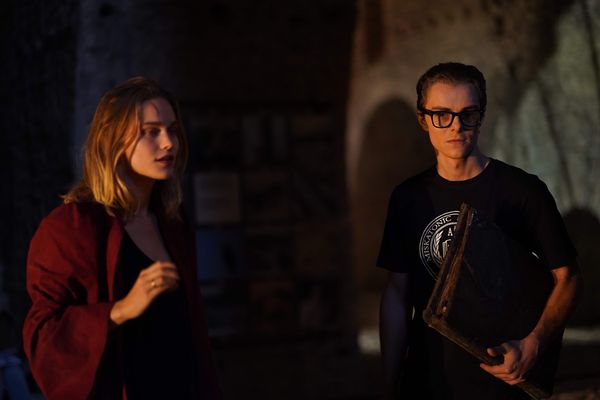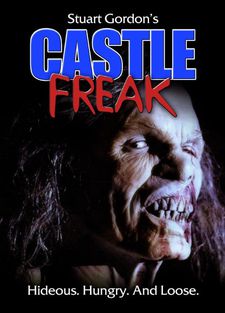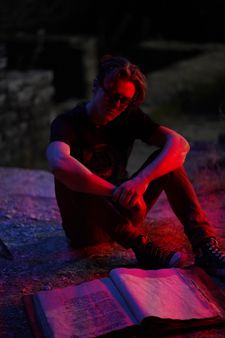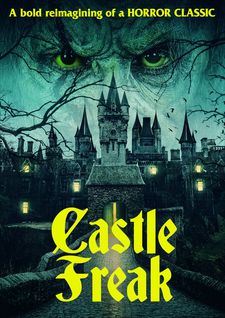 |
| Clair Catherine and Chris Galust |
One of those horror films that leaves a lingering impression, Stuart Gordon’s 1995 Castle Freak made a huge impact on audiences and remains a firm favourite with many genre fans. Now there’s a new Castle Freak out there courtesy of director Tate Steinsiek, and it’s also causing a stir. Tate had a lot to tell me in our recent interview, including his hope that this film will open the gates for a series of new cinematic ventures into the world of HP Lovecraft, but I began by asking him if he experienced any trepidation about taking on such a well established genre work.
 |
| Castle Freak 1995 poster |
“It's a strange thing. You know, it's something that I kind of got to experience the first time when I did the puppets for Puppet Master, you know, because those are characters that are are so loved. And they go way back for a lot of people. So it was an experience that I got to go through before when you see how much a character means to somebody.
“I really wanted to honour Stuart Gordon in his film, but at the same time give it a little twist for for, you know, for somebody new. The whole thing about the original film was that it was polarising. I remember when it came out, that even people in the horror industry thought it was too much. They were calling it torture porn and all this crazy stuff. And that's the whole thing about Castle Freak – it created polarising results. So I'm thrilled to create the exact same results.”
Did it help to have Barbara Crampton on board, as a friend of Stuart Gordon, to oversee that, and perhaps provide a bit more support?
“Oh, of course, yeah. To have Barbara there, you know, was necessary as we moved through the process because we needed to know that this is part of her legacy. So having her there to help us achieve the best film that we possibly could was necessary, and I think everybody knew that from the beginning.”
And how did they find their marvellous location?
“Well, Justin Martell, who is one of the producers of the Joe Bob Briggs show on Shudder, he had worked in Albania before. He and his partner, Matt Manjourides, were both producers in the film, so. So they had worked in Albania before and they brought it to the table. And they heard that we were, you know, producing this reboot. They approached, I believe it was Barbara, first, because she was on the Joe Bob show, and that's how it all came to pass. We actually knew somebody that had access to this gorgeous and amazing castle. So once we got to look at it, we decided to work together.”
I love the way the first part was shot, I say – it really it makes good use of the location. It's quite a romantic opening and it suggests that it's going to become a different kind of film...
 |
| The late Lavinia |
“I wanted to paint pretty brave regardless of the content. Regardless of if the story that was being told was terrible, I wanted the lighting to be beautiful. I wanted everything to look great. Because it's a sort of mix of the senses. The thing about the original cast is that it was so raw, it was so gritty, you know, everything that you saw, you almost felt like you weren't supposed to be seeing, it and that was part of the of the effect. I kind of wanted to add a layer to that. I wanted people to feel afraid of what they've seen.”
He likes the idea of getting viewers to relax, he explains, so that they’ll develop a sense of trust and won’t suspect that the film is going to do terrible things to them – although, of course, it is. Castle Freak was never intended for every horror fan, he says. I ask if he thinks that his background as an artist gave him a different kind of angle on the subject.
“Oh, yeah, yeah. You know, the entire purpose of this movie was to make people cringe. That was something that the producers talked about way, way way back before the script, is the true essence of Castle Freak is make people uncomfortable. Make them feel like you're seeing too much. Like do you really think you're badass and tough? Do you really think you're hardcore enough for that? You know, that was the whole thing that the original movie made me feel when I was watching.”
Was he interested in it from the point of view of what he could do with the creature as well, as someone who's worked on creature creation in the past?
“Yeah. When I first heard about this, I'm like, ‘Listen, I I have I have every checkmark, you know, I need to be the guy that makes this film.’ When I knew that I was putting the directors hat on, I knew that I wanted to call my buddy Wayne Anderson to be the guy to come in and create the look and feel of the freak itself. You know, it wasn't easy for me to hand over the reins, because I'm used to, even if I'm not making everything myself, at least controlling.”
There was an unexpected positive side to it, he says. “I got to feel that craziness that other directors feel working with guys like me. And so it was funny. It was funny to experience one when other directors go through. I really loved it. It was nice to like, turn over the turn over the keys. Let somebody else make monsters.”
 |
| Forbidden lore |
There's a lot of HP Lovecraft in the story as well. Was that something that affected the way he wanted to build up the aesthetic of the film?
“Yeah, because my whole thing with reimaginings or reboots, or whatever you want to call it, is you have to figure out a reason. Why are you doing this? What's the new story you want to tell? And then you know, the story of a story of a lost soul hidden away in the basement or in the catacombs of the castle and tortured his whole life only to escape and still be repelled by the family – that story was told beautifully in the original. And I didn't want to just try and make a better Castle Freak, because that's disrespectful to the original. It's disrespectful to Stuart.
“I never felt like it was a competition. What I wanted to do was I wanted to add, I wanted to add to the mythos, I wanted to create a link and expand on things. I always knew that the original was based on an HP Lovecraft story, The Outsider, even though it was only mildly touched upon. So just having that mild connection is all it took for me to say okay, let's make this a centre point, a crossroads of a bunch of different Lovecraft concepts, because obviously my goal in the future would just be to have this beautiful sort of reexamining of the Lovecraft universe, this being Iron Man in the Marvel Universe, you know, but that's the great thing about HP Lovecraft – it’s in the public domain. So you know, just like Frankenstein or Dracula, anybody that wants to invest their creativity in these beloved characters, you can do that. Which is why we kind of alluded in the extra scene at the end of the film, that we might play with some more familiar concepts.”
It was interesting that it references the character of Lavinia Whateley and The Dunwich Horror, and the idea of what might have happened if she had daughters instead of sons, I venture.
“Oh, thank you, I'm glad you found that interesting. And also I didn't want to completely destroy it, you know, because I wanted it to feel like the original story is intact as it was, and we're just sort of changing the timeline. Like, if I had had my wish, in the budget and the time and, you know, I would have wanted to make this a period piece and start further back in time so that we can work our way to a modern setting, which I thought would allow us a lot more range in all of the stories that we wanted to tell. But, of course, doing things like a period piece always comes down to budget, you know, when you when you have to time stamp everything in the frame, it just takes more money than producers like to dish out. So that was squashed early on, unfortunately.
 |
| Forming connections |
“I came into this project thinking way down the line. There wasn't just one project I wanted to do. We had the concept of a sequel. And I instantly had a lot of concepts. And I still do. And it sort of just depends on a lot of things, which way we go, or if we have another story to tell. I would love to see this in a year. The funny thing is – and I haven't actually really told anybody – This Castle Freak was intended as sort of a prequel. And that's about as much as I want to get into it. But yeah, the fact that the gender is changed, and everything that we knew about the Freak’s difference is not an accident and not an attempt to erase the original.”
With that in mind, I say, I liked the way that the film changed style at the end, moving from that elegant, very pretty set up early on to something that suddenly seemed much more directly in the spirit of Stuart Gordon.
“I appreciate that,” he responds. “One thing that I wanted to do was, again, I wanted to freak people out in the same way that Castle Freak freaks me out. And then I want to take it a step further. And that's, again, where the point of doing any sort of reimagining comes in. That's the thing that makes this new story worth telling...I was all too excited. In fact, I had ideas that were way bigger, originally, but again, that unfortunate reality of budget always comes into play, doesn't it?”
I note that I really liked some of the casting choices as well. Clair Catherine, I thought, was very good in the lead, and Chris Galust was a lot of fun as such a Lovecraft character. Did Tate have much control over casting?
“You always want to have full control. But in an independent film that's just impossible,” he says, “especially when the casting process is happening over the phone. And I'm already in Albania, and setting up for this film, and, you know, doing interviews as quickly as I can, if I get a chance to interview at all, so it is all of this crazy, crazy, crazy stuff. But that's just sort of the wonder of independent film, is it leads you down avenues that maybe you wouldn't have gone down before, including with your casting. It brings you people that maybe are outside of your normal, you know, preference. Like, I mean, let's be honest, my cast of characters, they are entirely too good looking, a beautiful bunch of people, you know what I mean?
 |
| Castle Freak 2020 poster |
“I'm a guy who, if you ask me my top 10 favourite films, you know, Gummo is in there Pink Flamingos is in there, the original Todd Browning Freaks is in there. So there's not a lot of beautiful aesthetic in my world of interest. So when I'm early on in casting, you know, I'm talking about all my ideas, and I'm, like, ‘We need we need this sort of looking person. And we need some really original, bizarre looking people and, you know, this is Lovecraft, who's going to take it there?’ And as the producers kind of look at each other, scratching their heads, and they're like, ‘Yeah, but we also have to have, like, decent looking humans as well.’
“So yeah, I opened my mind early on to the concept of having beautiful people in my very, very ugly movie, which was new for me, but I can't be more thankful or more grateful for David Guglielmo, who was my casting agent. He gave me all these beautiful people to choose from. And once I actually got past all of their sparkling good looks, and got down to the root of their performances. I was really pleased with the options that he brought me and finding somebody like Clair, who was a first time actor anyway. I didn't even realise that she was a first time accurate. To be honest, I thought that she had just forgotten to upload her CV when I was looking at her performance, but she's never acted before, which just added to a real sort of truth element. Clair, you know, she's a brave, ballsy person. And that's exactly what Rebecca has to be.”
Now that he’s taken on directing this kind of work, how is he planning to balance his career going forwards with direction, his art, creature creation and all the rest of it?
“Well, you know, I will always be a monster maker,” he says. “That much I know. What I don't know is in what physical regard because it gets very, very taxing on the body after a decade or two, you know what I mean? So the concept of using my mind more than my hands is necessary at this point in my life, and it's something that I want to do. You know, it was a fun experience, making someone else's script, but I will definitely say that the goal is that ever elusive written and directed by credit because as much fun as I had making this film, there's no real true examination of the filmmaker like one that they write, produce and create themselves...It's really my goal to breathe life into some of the atrocities that I've conjured. And I think that the core community will be very pleased that I'm putting my efforts into things like that. I have some pretty terrible stories to tell.”





















